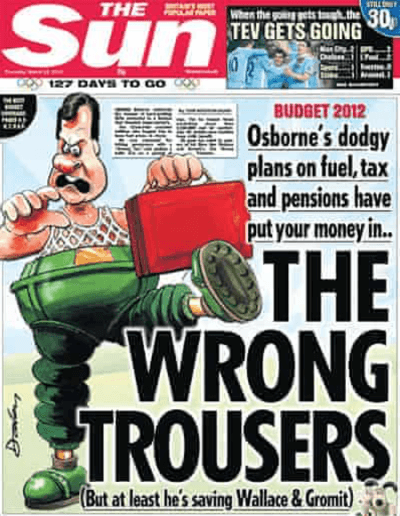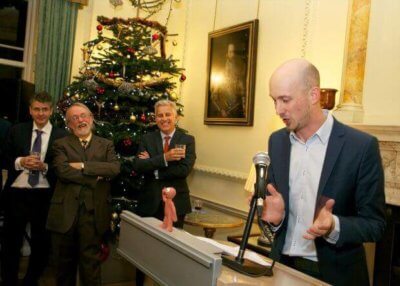The Decade Britain Got Animated Part 2: Taxing Stuff
The 21st of March 2012 marked a significant change in the fate of our animation output.
“…it is the determined policy of this government that we keep Wallace and Gromit exactly where they are.”
The words above uttered by Chancellor George Osborne in his budget were cause for celebration in the animation industry, and thanks to the perceived Wallace-like appearance of opposition leader Ed Miliband the cause for ridicule in the press. Political affiliations aside the power of British animation had made the front page and change was in the air for a weak and weary industry.

“But at least he’s saving Wallace and Gromit” The successful campaign to get UK animation tax incentives had influenced the front pages
Before 2012 British TV animation had seen a steady decline due largely to the fact that competitors overseas had benefitted from a healthy tax incentives from their government. This had led work away from the UK which led to a the disappearance of UK made animated shows on our screens, and animation studios on our streets (see part one of our series for more). Now that the government had promised a new tax relief things were looking promising for the industry as a whole. Companies making animation in the UK would receive 20% of their budgets back in the form of a tax rebate. If a company were spending £5million on a series they would receive £1million of the tax paid back which can be used to fill in any funding gaps for projects or to employ more people. Not only does this reinvestment create jobs, but it gave broadcasters confidence that the studios creating the work were supported and therefore not likely to close down halfway through production.
In the international world of TV production where an idea is sold to broadcasters, having the extra percentage of your idea “funded” gives you more to negotiate with and can help you retain rights to the IP. This was also good news for the government, who saw healthy returns on tax credits, as studios blossomed, so did animators, all paying taxes on their earnings. The tax relief also attracts service work (ideas from overseas) to the UK keeping the cashflow in the country and boosting the UK economy.
The sector-changing campaigning work of Animation UK, run by a small but dedicated group of people not only created the tax breaks but shone a light on animation, as a distinct sector in its own right as well as being a vital part of the wider screen and creative industries. In recognition of his part of the campaign in 2014 Oli Hyatt was given an MBE for his services to children’s TV and animation.
Animation UK wasn’t the only group fighting for a better animation sector. Parallel to the groups efforts Creative Skillset (as it was) had set up skills councils for different creative industries. The Animation Skills Council which ran from 2010 to 2015 would create a levy to ensure that alongside the growth of the sector, there would be collective investment in skills. The fund would take a small levy from productions in the UK which had benefitted from the tax credits. A company would donate 0.5% of their production (capped to £40k) to the fund which would be reinvested for training. The levy demonstrated to the government that animation in the UK meant business and The Animation Skills Council and Creative Skillset convinced them to more than match the money paid into the levy which funded Animation Trainee Finder, Animation Showcase, and storyboard courses run by Lupus Films alongside other outreach activities and events that would bolster the skills that the sector needed in order to grow. Kate O’Connor was a sector advisor during this period and witnessed the work taking place “Whilst Oli Hyatt was leading Animation UK with his unsung heroes securing the tax breaks, the Animation Skills Council and people such as Marion Edwards & Ruth Feilding (chairs during this period) and Louise Hussey (deputy chair and also responsible along with Lindsay Watson), and sector manager Helen Brunsdon and many others were the unsung heroines”. The levy provided a solid framework for the sector as O’Connor describes “It was for a common cause, such as training industry and freelancers and making sure that the skills base was kept in line with growth in the UK”.
And grow the sector did, with the tax breaks in place animation companies in the UK began to make TV again. In 2013, the year after the tax breaks came into force only one new TV series was commissioned from the UK, the evergreen Sarah & Duck, however the year after ten shows were commissioned with another ten the year after that with many of these shows such as Hey Duggee still running today. Confidence in British made animation had returned and the global brand was beginning to be recognised, not only had Animation UK and the Animation Skills Council saved a legacy, but new characters were being created.
With this growth came the need to develop ways of measuring the size, shape and needs of the sector. There were many other issues on which to represent animation, from the regulation and possible quotas to more promotion and advocacy and supporting exports. Whilst Animation UK continued to exist it was not a formally recognised trade body and the sector was in desperate need of a clear voice, and a formal route to making that voice heard.

The Animation Skills Council and the levy was paying its way ensuring that the needs of a growing industry were satiated by funds from the tax breaks before it closed in 2014 when Creative Skillset restructured to become Screen Skills. This restructure left the UK without a representative body for all things animated. When the government, Ofcom or any official regulatory organisations organise consultations having a trade body is essential because then the industry has that voice and that formal route to those bodies, animation didn’t have one.
Animation UK, perhaps the most natural fit for the role had to change if work produced in the country was to be represented properly. “It wasn’t a formal body” explains O’Connor “it was a very successful campaign group with a board and members but it wasn’t a properly constituted organisation that could represent industry”. Hyatt decided that the group needed to evolve to meet this need so that Animation UK could make the move from a campaigning group to a trade body that would be recognised formally by government and creative organisations such as the BFI, Arts Council England as well as being recognised by the Department for International Trade to support exports and tax grants and other vital mechanisms to keep animation going.
With the help of its founder members Aardman Animations, Blue-Zoo, Cake Entertainment, Entertainment One, Jellyfish Pictures, Lupus Films, Mackinnon & Saunders, Spider-Eye, Studio Liddell, The Elf Factory and Tiger Aspect, Animation UK was set up as a formal body. Exploring many options the decision was taken to join forces with the then UK Screen Association, and discussions commenced with Neil Hatton as CEO. The UKSA – represents the VFX, postproduction and film studies and facilities sectors. It was a natural fit for animation and the deal was done for Animation UK to retain its brand and identity, and to have a formal Animation UK Council responsible for Animation business & policy issues and advocacy and to drive forward the agenda. Animation UK would form part of the newly renamed UK Screen Alliance, sharing resources and working on common issues such as skills and mobility of labour. Whilst groups do exist for specific elements in industry and are specific to a role such as producers or writers, Animation UK does something different as O’Connor explains, “It’s not just a trade body for one role covering all of film and TV, it’s a trade body for the whole animation industry including service providers, studios, distributers.”

Oli Hyatt Launches Animation UK at Downing Street in December 2017
In December 2017 at a reception in Downing Street Animation UK, already known for its successful campaigning for the tax incentives formally launched as the voice of the animation industry. After years of campaigning for the animation industry and building the organisation from a campaign group to a trade body, Oli Hyatt joined the newly formed Animation UK Council and Kate O’Connor was appointed Executive Chair and Helen Brunsdon as Director.
Since 2017 Animation UK has been instrumental in representing animation where it is needed. In 2017/8 Ofcom carried a huge review of children’s content which Animation UK was able to evidence the decline in investment for UK originated animated content. It also lobbied for the contestable fund to be focussed on kids content, which is now the £58million Young Audiences Content Fund, Animation UK also sits on the steering committee and the newly formed Creative Industries Export Board, organising a greater presence at key markets such as MIFA and Kidscreen. Animation UK lobbies for and raises the need for more research and mapping to profile the sector, make sure investors and government understand its worth.
“We’re around the right tables, talking to the Treasury, DCMS, the Department for International Trade and regulators and industry bodies talking to them all about animation.” – Kate O’Connor Executive Chair, Animation UK
Picking up on the need for animated shorts was also an early campaign. “As one of the few countries without targeted investment in this vital part of the funding & investment ladder, we had no funding to help develop animated shorts, no permanent fund to support our new talent. With the campaign initiated between Animation UK and the Arts Council and following an extensive consultation led by Helen Brunsdon, the result of this was the BFI shorts fund and the first beneficiaries will be announced soon”
As we all know 2016 the United Kingdom held a referendum on its future relationship with the European Union. 96% of the creative industries voted to remain in the EU, however the majority of eligible voters in the UK voted in favour of leaving. With Brexit upon us and uncertain times ahead British animation looks to be back on the tightrope, swayed backwards and forwards by the winds of uncertainty surrounding our international trade. However the body remains close to its European colleagues with Animation Europe, lobbying that Creative Media funding is replaced if it is put at risk by Brexit. The members old and new are key to the Animation UK mission to act as a force for good for all those working in the animation sector O’Connor states “Animation UK needs to be right in the middle of it all, but can’t do it without its members”. Other organisations have a role in the upcoming struggle, but they don’t focus on animation nor represent the whole sector.

Over the decade, two major organisations have evolved to meet the needs of the UK animation sector
Though a trade body, skills and a strong talent pipeline are really important to ensure that there is trade to do, so it is important that organisations that have skills as part of their remit are constantly reminded of the importance of animation. This is what Animation UK does. “We’re here as a permanent body for business, sustainability and growth” “We are here as the body for business, sustainability and growth and we will continue to raise issues, campaign and make sure animation is firmly on the map to attract investment and shape policy and hold organisations with wider responsibility for funding and skills to account on behalf of sector ” Much of this work goes under the radar, but since 2010 Animation UK has been a central pillar to the growth of the UK animation sector, without it there might not even be a sector. Its presence has encouraged growth and confidence in British animation, but the growth has brought with it challenges.
Among these challenges are skills. The Animation Skills Council has been reborn and the levy mentioned earlier has been restated to meet some of these challenges but with more university courses producing budding animators and competition from overseas continuing to have an effect on the UK, what does the future hold for UK animation? The next article will cover these important issues
Catch up with Part One of “The Decade Britain Got Animated” here.

